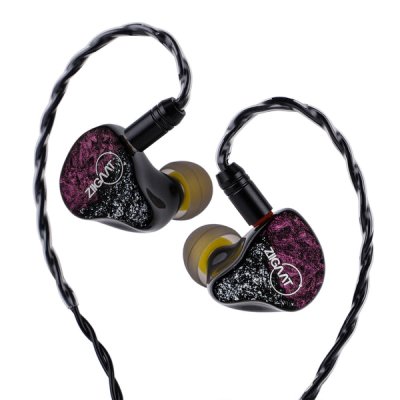Elysian Pilgrim and Ziigaat Odyssey are 1DD+3BA in-ear monitors. Elysian Pilgrim costs $400 while Ziigaat Odyssey costs $229. Elysian Pilgrim is $171 more expensive. Ziigaat Odyssey holds a slight 0.4-point edge in reviewer scores (7.3 vs 7.7). Ziigaat Odyssey carries a user score of 7.4. Ziigaat Odyssey has significantly better mids with a 1.7-point edge, Ziigaat Odyssey has better treble with a 0.5-point edge, Elysian Pilgrim has slightly better dynamics with a 0.3-point edge and Ziigaat Odyssey has better soundstage with a 0.5-point edge.
Insights
| Metric | Elysian Pilgrim | Ziigaat Odyssey |
|---|---|---|
| Bass | 7.3 | 7.5 |
| Mids | 6.6 | 8.3 |
| Treble | 6.9 | 7.3 |
| Details | 7.3 | 7.7 |
| Soundstage | 7 | 7.5 |
| Imaging | 7 | 7.7 |
| Dynamics | 7.3 | 7 |
| Tonality | 7.3 | 7.8 |
| Technicalities | 7.4 | 7.1 |
Elysian Pilgrim Aggregated Review Score
Average Reviewer Scores
Average Reviewer Score:
7.3Generally Favorable
Ziigaat Odyssey Aggregated Review Score
Average Reviewer Scores
Average Reviewer Score:
7.7Strongly Favorable
Reviews Comparison
Elysian Pilgrim reviewed by Gizaudio Axel
Gizaudio Axel original ranking
Gizaudio Axel Youtube ChannelBuy Elysian Pilgrim on HiFiGO
Ad
Price: $359.10
Buy Elysian Pilgrim on HiFiGO
Ziigaat Odyssey reviewed by Gizaudio Axel
Gizaudio Axel original ranking
Gizaudio Axel Youtube ChannelBuy Ziigaat Odyssey on Linsoul
Ad
Price: $229
Buy Ziigaat Odyssey on Linsoul
Elysian Pilgrim reviewed by Jays Audio
Youtube Video Summary
Hyped for good reason, Elysian’s Pilgrim pairs a sleek, carved metal shell with a genuinely upgraded cable and a refined, clean-balanced tuning. Technicals punch high for the price—resolution sits a notch above sets like Hype 4 and Dusk, while the bass shows tight texture, tidy decay, and neat separation. The low end isn’t as forward or “full” as Hype 4, trading slam for a more neutral and organized presentation that suits listeners seeking clarity over thump.
Vocals are naturally placed: not shouty, not distant, with a touch of air on the tail that avoids harshness. Compared with Dusk, the Pilgrim carries better upper-mid extension and a more complete, detailed midrange; it’s also a bit smoother and more natural up top, and adds a hair more sub-bass for engagement. As a package—sound, build, and unboxing—the Pilgrim reads like a polished, modernized take on that classic balanced recipe.
Context matters, though. As an all-rounder around $300–$400, Pilgrim would be an easy pick, but the Supermix 4 at ~$150 offers roughly “90% of the experience” with an even smoother tilt, pressuring its value case. On the horizon, Simgot EM10—if priced around $399–$450—promises more air, detail, punchier mid-bass, and a wider wrap-around stage, potentially overshadowing Pilgrim’s more chill, laid-back vibe. Practical notes: no obvious channel imbalance was heard, but the ring plating can scratch quickly, the fit is a bit shallow, and wider-bore tips help. Net: a beautifully made, balanced performer for those who value refinement and design, but with fierce competition today, some shoppers may prefer to wait or choose something more specialized (e.g., Hype 4 for bigger low-end).
Jays Audio Youtube Channel
Ziigaat Odyssey reviewed by Jays Audio
Youtube Video Summary
Ziigaat Odyssey lands as a mid-range focused set with a slight treble lift that really scales with volume. At relaxed levels it’s clean, calm, and easygoing; turn it up and the presentation becomes wide, airy, and immersive with a surprisingly punchy, rumbly low end for its graph. The new topology DD hits a sweet balance—neither sluggish nor hyper-snappy—delivering well-balanced bass that serves the tuning, even if ultimate slam/texture trails sets like Hype 4 or Xenns Tea Pros. Tip rolling toward slightly brighter tips adds a touch of treble energy and liveliness without pushing fatigue.
The star here is the midrange: instruments layer neatly with comfortable separation, and vocals sit clean and natural—not shouty, not veiled—though they can feel a bit too relaxed at mid volume. Treble is smooth yet detailed, revealing cymbal micro-info and air without harshness, and it’s noticeably cleaner than Explorer while avoiding metallic timbre. Technicals are solid for the price—a step up from Explorer and just behind “contet” in raw resolving power—yet more natural in timbre and notably more musical when driven louder. The tuning flatters slow rock, acoustic, indie, alternative, and ballads, where the Odyssey’s “turn-it-up” character shines.
For alternatives: those wanting warmer, bassier impact for hip-hop, rock, or metal may prefer Kiwi Ears K4, HBB Arcadia, or the Deuce for true bass-head needs. For mid-volume all-rounders with more instant engagement and technical pop, consider Supermix 4, Nova, Quintet, or Chopin; for airier, brighter takes with sweeter female vocals, look at Cadenza 4 or CKLVX. As a package, Odyssey feels like a future classic—gorgeous plating, a cable that could use an upgrade, and a uniquely immersive, high-volume experience that invites shutting out the world and sinking into the music.
Jays Audio Youtube Channel
Elysian Pilgrim reviewed by Jaytiss
Youtube Video Summary
Elysian’s Pilgrim shows up with a small, comfortable shell and a tidy, premium-feeling case—white on the outside, a bit papery inside, but practical. Fit leans shallow; a grippy tip helps keep things steady. The unit measured with excellent channel matching and tracks closely to a preferred target, setting the stage for a confident first impression.
On sound, Pilgrim delivers punchy bass with real note weight and slam, natural mids, and imaging that locks in place. There’s a touch of metallic/lush timbre and an ear-gain region that can feel a bit forward, but the overall tonality stays engaging. It’s not a “baby Annihilator”: the big sibling still brings deeper sub-bass and a cleaner upper register, while Pilgrim feels a little more fun and lively. Versus Hype 4, the two trade blows—late vs. early ear gain—with Hype 4 getting a slight nod for some tastes; against the Mega 5 EST, Pilgrim is the more exciting listen and, at roughly $150 less, the stronger value.
Ranking wise, Pilgrim sits among the best at its price, even sparring with costlier sets, though it stops short of heavy hitters like Grand Maestro, Annihilator, Jupiter, or Velour. Assuming the rumored $350–$450 bracket, the package—sound, cable, and case—is compelling. Minor quirks in the ear-gain area aside, this is an exceptional IEM with a full recommendation, and there’s even a Noir version on the horizon for those curious about variants.
Jaytiss Youtube Channel
Ziigaat Odyssey reviewed by Jaytiss
Youtube Video Summary
Single-DD + 3BA hybrid with a clean, confident look: thick shell, metal nozzle that grips tips well, visible rear vent, and the preferable flat 2-pin connector. The standard Ziigaat case feels premium if a bit unexciting. Sonically, Odyssey lands a balanced, tastefully energetic tuning—ample bass for most listeners, elevated upper mids for presence, and a smooth, clean upper-treble. Out of the box it sounds immediately right and counts among the better-tuned sub-$300 IEMs. The catch: macro/micro detail and imaging are good, not mind-blowing, keeping overall technical performance at “appropriate for the price.”
Within Ziigaat’s lineup, Arcadia skews darker with less treble reach, Xeno/Ceno feels a bit treble-shy, and Dinko is the more V-shaped, poppier pick with extra sub-bass. Explorer overlaps in tonality but Odyssey adds more upper-mids energy and refinement—albeit at a higher price. Among peers, AFUL’s P7 brings the stronger technicals and a slightly more neutral sheen, K4 trades blows, and “Quattro” may edge tuning purity. As an all-rounder, though, Odyssey hits a sweet spot: rich mids, fun but controlled bass, convincing note weight, and a natural stage, even if the far-upper air can temper ultimate sparkle.
Verdict: a fantastic mid-tier set with high price-to-performance, gorgeous faceplates, and a crowd-pleasing tonality; accessories are a bit underwhelming, and the top-end “air” won’t wow technicality chasers. Scored around 8.8/10 and easily recommended as a safe, musical choice—especially when discounts bring the sticker down.
Jaytiss Youtube Channel
Elysian Pilgrim reviewed by Tim Tuned
Youtube Video Summary
Elysian Pilgrim hits that rare sweet spot: a truly affordable entry into the brand’s house sound that still feels flagship-adjacent. Think Gaia DNA with a more tamed signature—the bass is dynamic, punchy, thumpy yet modest in quantity, staying clean with no bleed into the lower mids. Vocals sit center-stage with a touch of thickness, generally natural timbre and only a hint of grain that comes from the energetic top end. It’s a balanced, non-boomy low end for everyday listening; bassheads may want +1–2 dB more.
The star is the treble: incisive, nuanced, and genuinely “end-game” in detail retrieval at this price. Treble quality tracks closely with Gaia, still shy of the Annihilator, but astonishing for $399. Overall technical performance is the wow factor—notes feel crisp, tactile, high-definition, sitting well above sets like the Blessing 3 while only lightly trading away smoothness, and doing so tastefully. It reads as a “high-res” listen without slipping into harshness.
Against peers: Studio 4 stays smoother and more natural, but Pilgrim brings more energy and clearly higher detail. Versus the Hype 4, the latter has more bass quantity, yet Pilgrim wins in treble timbre and overall resolution. Compared with Moondrop x Crinacle Dusk, rankings shake out with Pilgrim first in treble and technicals, while the DSP Dusk often leads for bass/vocals over the analog version. Verdict: a big green thumbs up—an A+ for delivering thrilling, highly technical performance that competes above its class. (Interview notes: the Pilgrim Noir variant aims warmer, includes an Eros S cable and luxe case at a higher price, while standard Pilgrim stays the brighter, value-focused pick.)
Tim Tuned Youtube Channel
Ziigaat Odyssey reviewed by Tim Tuned
Youtube Video Summary
Ziigaat Odyssey takes the new Meta tuning and gives it a more V-shaped, exciting twist. It keeps the beautiful mid-range intact while adding extra energy to both bass and treble, landing closer in spirit to Moondrop x Crinacle Dust (DSP) and Kiwi Ears K4—but with more swagger. It’s not as strictly on-target as those sets, yet the result is more engaging and solves the “too safe, sometimes boring” side effect of many Meta-tuned IEMs.
Beyond tuning, Odyssey brings real upgrades in technical performance for the price. Bass dynamics are punchier and more well-defined than K4, and treble nuances come through with greater clarity while preserving that natural vocal center. At $229, it undercuts many competitors and still feels like a step up—an easy pick for listeners who want Meta’s mid clarity with extra excitement and better slam without sacrificing coherence or comfort.
Tim Tuned Youtube Channel
Elysian Pilgrim reviewed by Head-Fi.org
Ziigaat Odyssey reviewed by Head-Fi.org
Elysian Pilgrim (more reviews)
Elysian Pilgrim reviewed by Yifang
Elysian Pilgrim reviewed by Audionotions
Elysian Pilgrim reviewed by Z-Reviews
2025-07-17Youtube Video Summary
Elysian Pilgrim hits the rare $400 bracket with a hybrid recipe—1× LSR dynamic and 3× Sonion BA—and a presentation that pulls the stage in. Instead of big, floaty width, the image clamps down with laser focus: vocals and transients sit right there, almost “under the skin.” Well-recorded tracks pop with mic-placement clarity; poorly recorded ones get called out instantly. Bass is punchy and structurally correct rather than boosted—not a basshead set, but it thumps when the mix calls for it. It scales across amps (from clean to tubey), with some chains teasing a bit more soundstage while keeping that intimate, hyper-detailed character.
Build is slick: a comfortable, not-too-thick shell with a machined aluminum back and proper venting. The star quirk is the Pentaconn Ear connector—rotational like MMCX but far more robust—which also means most existing cables won’t fit, so the stock cable (often 4.4 mm, with 3.5 mm or both for extra) becomes the default. The earhooks curve a bit aggressively but can be reshaped; comfort overall is easy listening. Accessories are fine but not lavish: SpinFit tips and a big showpiece case that’s cool, if not pocketable.
Sonically it’s a “punch-drunk focus” specialist: drives through track after track, rewards great recordings, and refuses to sugarcoat weak ones. The Pilgrim feels special because of that concentrated energy and neutral-honest bass—more “truth serum” than lounge lizard. Verdict: 9/10. Docked for cable ecosystem quirks and a modest accessory spread, but the sound is compelling enough to make that nitpicking feel small. Curiosity about the pricier Pilgrim Noir stays high, yet this standard model already delivers a distinctive, addictive ride.
Z-Reviews Youtube Channel
Elysian Pilgrim reviewed by Shuwa-T
Elysian Pilgrim reviewed by Smirk Audio
Elysian Pilgrim reviewed by Super* Review
Youtube Video Summary
The Elysian Pilgrim brings boutique flair to a more reachable $400 tier with a metal shell that mixes matte and glossy milling, a comfy medium fit, and a plush two-core cable that’s nicer than most in the class. Notable is the Pentaconn connector—smooth to rotate and said to be durable—though cable swapping is less convenient if the stash is mostly 2-pin/MMCX. Accessories feel thoughtful (including unique black-core SpinFit tips), while the case skews a bit large.
Sonically it’s a well-balanced, slightly midrange-focused tuning with a clean sub-bass lift (below ~150 Hz) that can read “bass-light” on tracks heavy in mid-bass. Treble isn’t pushed; presentation comes off a touch brighter/open than the curve suggests, with solid imaging and agreeable vocal clarity. Compared to an earlier show demo, the production unit’s top end feels nerfed: those delicate, Plucky treble transients and the weight in high-hat percussion that once stood out are dialed back for a safer listen.
In the $400 cohort—Yanyin Canon 2 (warm, meaty), Thieaudio Hype 4 (leaner mids, thicker bass), Moondrop Dusk (clinical neutral with sub-bass and forward vocals), and Softears Studio 4 (brightest, most lively)—Pilgrim slots squarely mid-pack: agreeable, but less distinctive than the more characterful peers. Had the show tuning shipped, it would spar closer to the front; as is, the take is competent yet conservative. Final verdict: three stars out of five—a quality set that favors balance over excitement in an increasingly competitive bracket.
Super* Review original ranking
Super* Review Youtube ChannelZiigaat Odyssey (more reviews)
Ziigaat Odyssey reviewed by Bad Guy Good Audio
Bad Guy Good Audio original ranking
Bad Guy Good Audio Youtube ChannelZiigaat Odyssey reviewed by Audio Amigo
Youtube Video Summary
Ziigaat Odyssey comes in at $230 with a four-driver hybrid (1DD + 3 BAs) that’s very easy to drive. Build is the usual Ziigaat: full 3D-printed resin shells with metal nozzles and filters; sturdy and comfortable for average-to-larger ears, while tiny ears get a technical pass. The weak spot is the accessories: a basic cable (3.5mm or 4.4 option), one set of soft silicone tips plus foams, and a leatherette case that feels flimsy—underwhelming at this price. Aesthetics score well with a sparkly faceplate that the “Council of Ladies” mostly favors, even if it doesn’t always trigger compliments.
Sonically, Odyssey aims for warm-neutral with a tasteful bass boost. Sub-bass texture can run a touch soft, but mid-bass punch is addicting, giving kick drums and bass guitars real drive without boom. Lower mids are warm and slightly veiled in a pleasant, retro-leaning way; female vocals sit a bit back yet remain clean. Treble is safe but present—enough sparkle and clarity to balance the bass without sting, though true treble-heads may want more air. Technicals are solid for the bracket: good resolution, excellent separation, precise imaging, and an average-sized but convincing stage. With a 15–30Ω adapter, the FR tilts more V-shaped (more bass/upper-mids/treble), a fun twist for occasional variety.
Against peers, Odyssey is the relaxed, safer listen: warmer and less contrasty than EPZ P50 (brighter, more vocal-forward) and Kiwi Ears K4 (more V-shaped excitement), and a middle ground between AFUL Explorer (darker, bassier) and AFUL Performer 5+2 (airier, more resolving with stronger female vocals). Not the pick for bass-heads, treble-heads, or libraries packed with K-/J-pop divas, but a killer one-and-done all-rounder for mixed libraries that value warmth, balance, and zero fatigue. Despite the skimpy pack-ins, the tuning and performance earn a spot in “this is brilliant.”
Audio Amigo Youtube Channel
Ziigaat Odyssey reviewed by
 Fresh Reviews
Fresh Reviews
Youtube Video Summary
Ziigaat’s 2024 lineup lands three distinct flavors: the R (1DD+4BA), Arcadia (1DD+2BA), and Odyssey (1DD+3BA)—all sharing the same case, tips, and cable, but with very different tunings and striking faceplates. Pricing lives in the approachable range (roughly $200–$250), and the shells are well-built 3D-printed resin. The Odyssey’s nozzle appears slightly wider than the R’s, and its cloudy pink/silver faceplate looks clean and premium without the flashiness of Arcadia’s green/yellow sparkle.
For competitive play, title-by-title differences matter. In Valorant, Arcadia’s extra warmth and bass impact feel immersive but a touch boomy/bloomy under heavy ability spam—solid, around a B. The R and Odyssey perform on par with high marks; the R’s 1–3 kHz lift sharpens clarity and verticality, while Odyssey is more neutral and less bright. In Apex Legends, Arcadia struggles as bass bloom masks micro-cues (B–/C+). Odyssey delivers great separation/layering with slightly softer overhead cues (B+/B), and handles gunfire more comfortably than the R. In CS2, Odyssey takes the lead for its imaging, depth perception, and non-fatiguing balance; in Warzone, the order shifts to R > Arcadia > Odyssey, with Arcadia’s warmth helping vertical reads and impact.
As a music set, the Odyssey is a standout: potent, tight bass with clean transients, balanced mids that aren’t smothered, and a clean, non-sibilant treble that avoids fatigue while letting micro-detail through. It lands as a favorite in its price bracket—an easy recommendation for listeners who want a neutral-leaning all-rounder that still punches hard, splits cues well, and won’t scorch ears with gunfire or treble glare.
Fresh Reviews original ranking
Fresh Reviews Youtube ChannelZiigaat Odyssey reviewed by Web Search
The Ziigaat Odyssey offers a balanced take on the popular Meta tuning, emphasizing sub-bass rumble while maintaining a clean midrange. Its bass provides satisfying depth without bleeding into the mids, making genres like electronic or hip-hop engaging. Vocals come through clearly and naturally, though some listeners might find them lacking a touch of emotional expressiveness or "magic" compared to more specialized sets . The treble is generally smooth and inoffensive, avoiding harshness but sacrificing some sparkle and micro-detail retrieval .
Technically, the Odyssey presents a wider-than-average soundstage, though depth and height are more modest. Instrument separation handles moderately complex tracks competently but can struggle with dense passages. Its strength lies in its cohesive driver integration and natural timbre, minimizing typical BA artifacts . Comfort is good for most despite the resin shells, but isolation is average due to the venting design. The included accessories, particularly the stiff silicone tips and non-modular cable, are weak points for the price .
Overall, the Odyssey is a versatile performer prioritizing enjoyable tonality and listenability over technical brilliance. It's an easy recommendation for those seeking a well-tuned, non-fatiguing hybrid around $200, especially if tip rolling is employed. However, detail enthusiasts or those needing maximum isolation might look elsewhere .
Elysian Pilgrim Details
Driver Configuration: 1DD+3BA
Tuning Type: U-Shaped
Brand: Elysian Top Elysian IEMs
Price (Msrp): $400
Support our free service! Buying through our affiliate links costs you nothing extra:
Ziigaat Odyssey Details
Driver Configuration: 1DD+3BA
Tuning Type: Neutral with Bass Boost
Brand: ZiiGaat Top ZiiGaat IEMs
Price (Msrp): $229
Support our free service! Buying through our affiliate links costs you nothing extra:
Elysian Pilgrim User Review Score
Average User Scores
Average User Score: n/a
Based on 0 user reviews
No user reviews yet. Be the first one who writes a review!
Ziigaat Odyssey User Review Score
Average User Scores
Average User Score:
Based on 2 user reviews
7.4Generally Favorable
Elysian Pilgrim Gaming Score

Gaming Score & Grade
- The gaming score is prioritizing technical capabilities of the IEM (Separation, Layering, Soundstage) and good value.
Gaming Score
7.1Gaming Grade
A-Ziigaat Odyssey Gaming Score

Gaming Score & Grade
- The gaming score is prioritizing technical capabilities of the IEM (Separation, Layering, Soundstage) and good value.
Gaming Score
7.5Gaming Grade
AElysian Pilgrim Scorings
Average Technical & Tuning Grades
Average Tunign Grade
A-- It balances warmth and clarity well, showing only minor quirks along the way. Timbre feels believable with most instruments.
Average Technical Grade
A-- A competent technical showing keeps separation intact while delivering modest staging. It feels tidy even when recordings stack layers.
Ziigaat Odyssey Scorings
Average Technical & Tuning Grades
Average Tunign Grade
A- You get a polished tonal profile that stays natural from bass through treble. Subtle tuning choices keep things engaging.
Average Technical Grade
A-- A competent technical showing keeps separation intact while delivering modest staging. It feels tidy even when recordings stack layers.
Elysian Pilgrim User Reviews
"This is an example review"
Pros
- Example pro 1
- Example pro 2
Cons
- Example con 1
- Example con 2
Share your experience and build your personal ranking list.
You need to be signed in to write your own reviewZiigaat Odyssey User Reviews
Share your experience and build your personal ranking list.
You need to be signed in to write your own reviewVery pleasing to listen to. A good starter mid-fi set that seems to cater towards neutrality while decently technical. Sibilance at higher volumes in the 6-8khz region. Good for gaming, but can get convoluted at times.
Pros
Extremely smooth mids. Bass response is very clean, and doesn't bleed into the mids much.Cons
Strange sibilance in the 6-8khz region, easy fix with eq. Doesn't seem to have very good treble extension. The recessed 1.5-2khz region causes vocals to sound distant - can be good depending on preferences.It's an easy recommendation. The tuning is great. Tech is okay, but nothing special
Pros
Fun but still "accurate" sounding signature. Comfy shell with nice design.Cons
The cable requests to be replaced. Nothing special in terms of technicalities.Find your next IEM:
IEM Finder Quiz
newIEM Comparison Tool
newVS





























